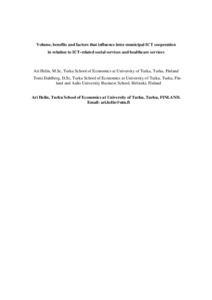Volume, benefits and factors that influence inter-municipal ICT cooperation in relation to ICT-related social services and healthcare services
Ari Juhani Helin; Tomi Dahlberg
https://urn.fi/URN:NBN:fi-fe2021042718297
Tiivistelmä
Information and communication technology (ICT) has become an integral part of the daily municipal administration, production and development of municipal services. Social services and health care account for ≥ 50% of municipal ICT expenditure. Municipalities operate and develop their ICT activities with limited ICT resources. This is an incentive for inter-municipal ICT cooperation. Four sets of secondary data are analysed in this article to evaluate how ICT cooperation is carried out in 20 Finnish municipal regions. Transaction cost economics (TCE), resource-based view (RBV), resource dependency theory (RDT) and the concepts of Granovetter’s social network theory are reviewed. The data are used to describe the expected and perceived economic and social benefits of inter-municipal ICT cooperation, and to understand the social connections that influence the execution of inter-municipal ICT cooperation. The data analysis revealed distinctive differences in the amount and forms of ICT cooperation, and regarding its governance. The results suggest that public organisations were able to benefit substantially from well-organised ICT cooperation. The characteristics of social networks were also found to relate to variations in the degree to which ICT cooperation was performed.
Kokoelmat
- Rinnakkaistallenteet [27094]
